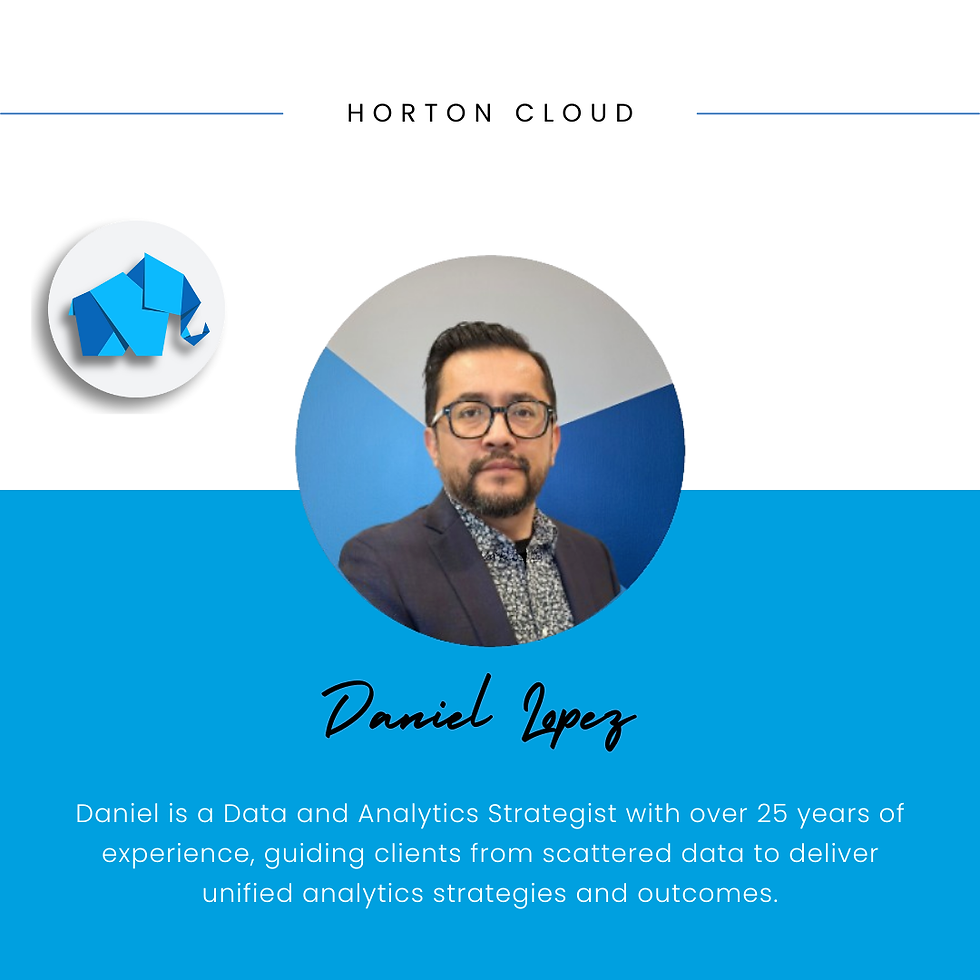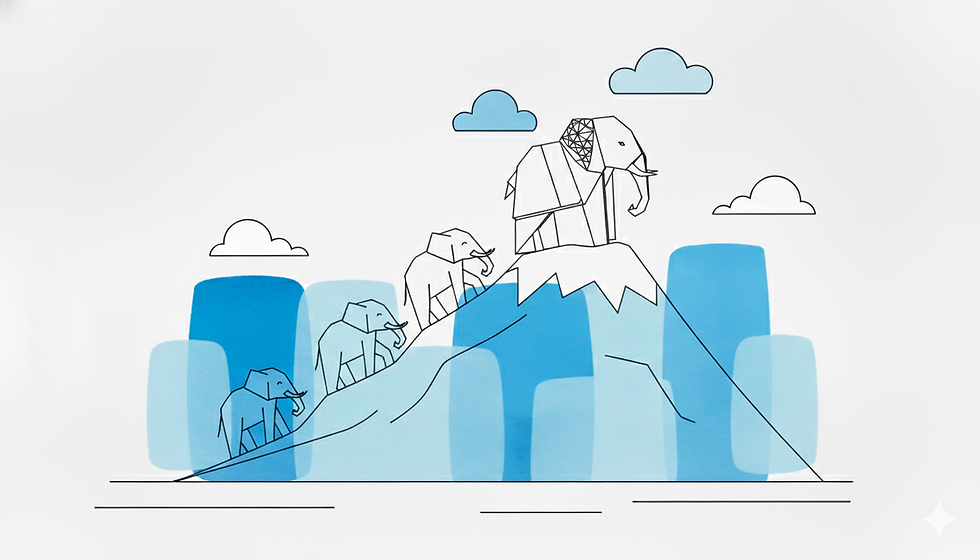Understanding Your Data Journey
- Daniel Lopez

- Sep 26
- 8 min read
Updated: Oct 8
Part 1: How Organizations Capture Information at the Source to Power Downstream Intelligence
Imagine standing at the edge of a vast river system, watching countless streams converge into a powerful current. This is what data looks like in today's organizations—multiple sources flowing together, each carrying valuable information that, when properly channeled, can power your entire business ecosystem. But unlike a natural river that flows on its own, your data journey requires careful orchestration at every stage.
In this three-part series, we'll explore how successful organizations transform raw information into strategic business value through a sophisticated three-phase journey: Collecting, Preparing, and Unlocking the Value of your critical business Data. Each phase builds upon the previous one, creating a continuous cycle that turns your organization's everyday activities into actionable intelligence.
Your data follows a natural progression through three distinct phases, much like water flowing from mountain springs to fertile valleys. Understanding this complete journey helps you see how each phase depends on and enables the next.

Collect - Where Everything Begins
The collection phase is where your organization first captures the tributaries that will eventually power your analytical engines. This phase establishes the foundation for every insight, decision, and innovation that follows. Every customer transaction, every sensor reading, every social media interaction, they all enter your ecosystem here, bringing the raw potential that will fuel your business intelligence. The strength and sophistication of your collection methods determine how much value you can ultimately extract downstream.
Prepare – Where things Converge
Once collected, data needs organization and structure to become useful. The preparation phase is where data convergence happens, separate streams merge into managed reservoirs like structured warehouses for core business metrics, flexible lakes for diverse information types, or modern lakehouses that handle both. This phase brings data from different sources together in common formats, enabling connections between previously isolated information. How well you prepare and organize your converged data directly affects how easily teams can access and combine information for analysis and further insights.
Unlock - Powering Your Business
The final phase is where prepared data drives actual business outcomes. All the collection and preparation work leads here, where information reaches the people and systems that need it. Modern organizations use various methods to distribute insights from automated dashboards to predictive models to real-time alerts. The value emerges at convergence points where previously isolated data streams combine to create comprehensive business intelligence that can be disseminated and actioned by your organization. Effective strategies ensure the right information reaches the right people at the right time, enabling better decisions across the organization.
Now, let's explore the critical first phase in detail: how to build a data collection system that sets your entire data journey up for success.
Part 1: The Collection Phase
Engineering Your Information Intake System
The Business Imperative of Strategic Collection
Every piece of information that drives your business decisions begins its journey at the point of collection. Collection establishes the foundation for your entire data ecosystem—determining what information enters your organization, when it arrives, and in what condition.
The way you collect data affects everything that follows.
Real-time collection enables immediate responses to customer needs and market changes.
Scheduled collection provides efficient processing for large-volume operations.
The quality standards you establish at collection determine the reliability of every analysis downstream.
In today's data-driven economy, organizations need comprehensive visibility into their operations, customers, and markets. This visibility starts with effective collection—capturing the right information at the right time from the right sources. When collection works well, data flows smoothly through your organization, enabling timely decisions and insights. When it doesn't, gaps and delays compound throughout the system.
Understanding Your Collection Options
Data enters your organization like tributaries feeding into a river system starting as multiple streams, at different volumes, and with varying currents. Each collection method serves specific business needs, and successful organizations orchestrate a strategic mix based on those.
Batch Processing: The Scheduled Release
Batch processing operates like controlled releases. They are efficient for managing large volumes but operating on fixed schedules. Similar to a dam collecting water throughout the day and releasing it at predetermined times, batch processing accesses an accumulation of data for periodic processing.
When batch processing excels:
Processing large volumes of transactions efficiently (payroll, billing, reconciliation)
Analyzing historical trends where real-time updates add no value
The inherent trade-off: You're always looking backward. If problems emerge Tuesday morning, you might not know until Wednesday's reports.
Real-Time Processing: A Continuous Current
Real-time processing maintains a constant flow of information, like a stream that flows steadily past monitoring stations, each drop of data processed as it arrives. Data flows continuously, enabling instant responses to events, thresholds, or changing conditions.
When real-time becomes essential:
When business value depends on responding to changes as they happen
When the speed of response determines competitive advantage
When delays between events and actions directly impact outcomes
The investment consideration: Higher complexity but may be required for use cases where reaction time provides competitive advantage.
Micro-Batch Processing: The Managed Flow
Micro-batch processing finds the sweet spot between extremes, like irrigation channels that open periodically to deliver measured amounts of water. It provides near real-time capabilities with more manageable complexity.
When micro-batch makes sense:
When "recent enough" (Minutes/Hours) delivers the business value needed
When aggregated views provide more efficiencies, value and insights
When near real-time achieves the same outcomes as real-time
Change Data Capture (CDC): The Efficiency Multiplier
CDC captures just the variations in the underlying Data. It acts like a water meter that only captures/measures flow when something changes instead of constantly monitoring the entire river system. This delta collection approach dramatically reducing processing overhead while ensuring nothing important gets missed.
When CDC delivers value:
Efficiently synchronizing data across multiple systems in near real-time
Maintaining audit trails of exactly what changed and when
Enabling event-driven architectures without full data copies
The practical benefit: Process only what has changed, dramatically reducing processing volumes while improving timeliness.
The integrity challenge: May require periodic full synchronization to prevent gradual drift between source and destination systems over time.
Implementing Effective Collection
Building your robust data collection system starts with establishing clear data pipelines, the channels through which information flows from source to destination. Modern pipelines are constructed using a combination of ingestion tools, transformation logic, and routing mechanisms that work together to move data efficiently and reliably leveraging the right patterns outlined above.
An implementation typically follows these key steps:
Design Your Pipeline Architecture -> Start by mapping data sources to their destinations, identifying what transformations are needed along the way. Choose between simple flows or hub-and-spoke patterns for complex ecosystems. Define how each pipeline handles errors, data validation, recovery and retries, and monitoring building in reliability from the start.
Select Your Technology Stack -> Select a Platform that has a suite of tools that match your collection needs and patterns, e.g. streaming platforms for real-time flows, ETL tools for batch processing, and modern ELT solutions that leverage cloud computing power. Ensure your choices support your current needs while allowing future growth.
Establish Monitoring and Observability -> Deploy comprehensive monitoring that tracks data volumes, latency, error rates, and quality metrics. Build dashboards that give real-time visibility into pipeline health. Set up alerts that notify teams before small issues become major problems. These will help to reduce system downtime, accelerate recovery when issues arise, and maintain the continuous flow of data and intelligence your organization depends on.
Building an effective collection system will also require addressing several critical challenges and embracing emerging capabilities for long-term successful outcomes.
Challenge 1: Breaking Down Data Silos
The Problem: Different departments create isolated data lakes with no outflow channels, trapping valuable information where it can't benefit the wider organization. Sales data sits in one lake, customer service in another, and operations in a third with each containing insights that could enhance the others if only they could connect.
Strategies to Consider:
Foster understanding of how data sharing strengthens both individual departments and the enterprise
Establish data governance that spans organizational boundaries
Deploy integration platforms that bridge disparate systems
Create and distribute shared data models that ensure consistency
Challenge 2: Ensuring Data Quality at the Source
The Problem: Garbage that enters your tributaries inevitably flows into your reservoirs, contaminating everything downstream. Bad data at collection such as duplicate entries, missing fields, inconsistent formats, pollutes your analytical pools and leads to flawed insights.
Strategies to Consider:
Implement validation rules at every entry point
Deploy automated quality monitoring with alerts
Establish data stewardship roles with clear accountability
Create feedback loops that fix problems at their source
Challenge 3: Building for Scale from Day One
The Problem: Systems designed for small streams struggle when volumes surge. Narrow channels that handled gentle flows efficiently suddenly face significant data flows, causing backups with information taking much longer to reach the destination. Also, during peak periods, these bottlenecks can create floods that overwhelm the system entirely, causing outages when you need data most.
Strategies to Consider:
Design/Build systems that can expand on demand
Design for parallel and distribute processing to avoid single bottlenecks
Assume significant growth from the start
Track capacity trends before they become constraints
Challenge 4: Embedding Security Throughout
The Problem: Every stream carries sensitive data that should be protected as it flows through your organization. Like securing water supplies from contamination, your data tributaries face constant threats from external breaches trying to poison the flow to internal leaks that could expose critical information. Without proper safeguards at collection points, you risk exposing sensitive information at every stage.
Strategies to Consider:
Consider encryption of data for both in motion and at rest for sensitive data
Implement fine-grained access control strategy across the organization
Apply security policies consistently across all entry points and collection processes
Emerging Capabilities Transforming Collection Process
Organizations embracing new innovations are gaining competitive advantages. These aren't just technical upgrades; they're fundamental shifts that could push companies to thrive in the digital economy.
Some of these innovations include:
Cloud-first, serverless strategies/services: Elastic scaling that can grow with your data
AI-powered data quality: Automatic detection and correction of contaminated data
Self-service data access: Business users can tap new tributaries without IT bottlenecks
Edge computing: Processing at the source before data enters the main flow
DataOps: 10x faster deployment of new collection channels
AI-powered data integration: Smart routing that connects previously isolated streams
Next: From Collection to Preparation
You've built the intake systems that channel data into your organization. The streams are flowing, quality is monitored, and security is embedded. But isolated streams, no matter how pure, create limited value until they converge in common reservoirs. That's where preparation comes in, to create the space where confluence and convergence points emerge and separate flows unite to surface critical insights.
In our next installment, we explore how modern storage architectures transform collected streams into strategic reserves ready to power your organization.
You'll discover:
Why traditional data warehouses alone no longer suffice
How data lakes provide flexibility at scale
When lakehouses offer the best of both worlds
Which approach matches your specific business needs
We'll discuss data storage strategies that don't just store your data but transform it into accessible, trustworthy business intelligence through data convergence. Just as a well-designed reservoir system ensures water is available when and where it's needed, your data preparation strategy ensures information is connected and flows smoothly to power decisions and insights, unlocking its full potential.
The journey from raw streams to refined insights continues. Your collection systems are the crucial first step, but it's in the preparation phase where data truly begins its transformation to set the stage to discover competitive advantages.



